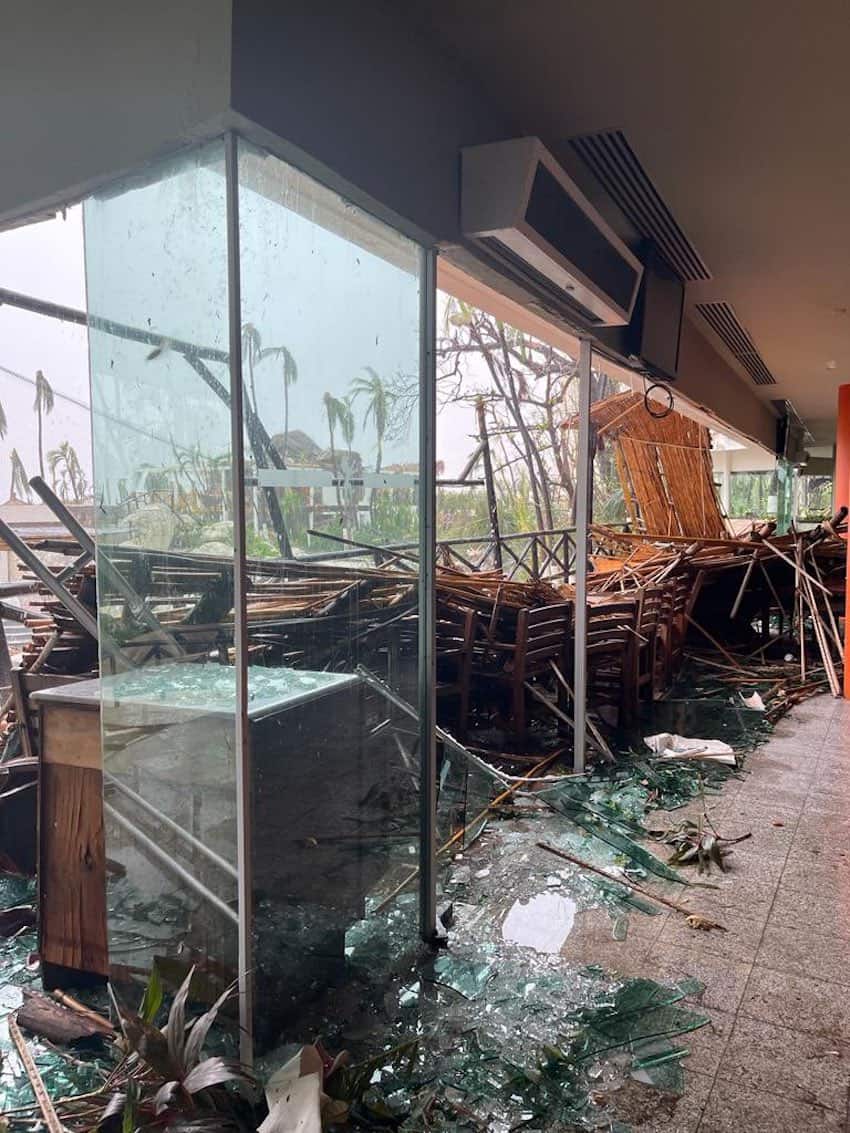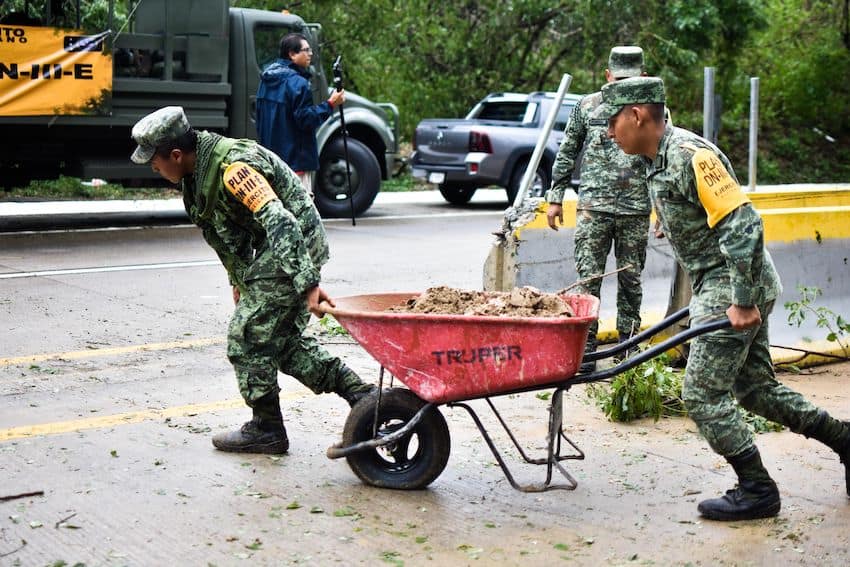The federal government has announced a preliminary death toll from Hurricane Otis a day after the powerful Category 5 storm slammed into the Pacific coast near Acapulco: 27 dead and four others missing.
Security Minister Rosa Icela Rodríguez said Thursday morning that the federal government received news of the deaths from the Guerrero government and municipal authorities in Acapulco. She said that the government was awaiting more information on the destruction caused by Otis, which strengthened rapidly on Tuesday to become the most powerful hurricane to have ever hit Mexico’s Pacific coast.

President López Obrador told his morning press conference that one of the victims was an off-duty soldier who died when a wall in his home collapsed on top of him.
“We very much regret the loss of 27 human beings,” he said, without offering any additional details about the 26 others who lost their lives.
“That is what hurts the most, because the material damage can be attended to and we’ll do it with great responsibility,” López Obrador said.
He said that three of the missing are navy marines.
The explosive intensification of #Otis from Tropical Storm to Category 5 Hurricane in only a few hours, followed by a devastating landfall near #Acapulco, Mexico. pic.twitter.com/fA3xtRYpGK
— Zoom Earth (@zoom_earth) October 25, 2023
“The people sheltered, protected themselves and that’s why fortunately there weren’t more tragedies, loss of human life,” López Obrador said, although the death toll appeared likely to rise given that the full impact of the hurricane isn’t yet known.
Some 10,000 military and National Guard personnel are assisting the response to the disaster, but on Wednesday they “lacked the tools to clean tonnes of mud and fallen trees from the streets,” the Associated Press reported. More machinery is expected to arrive in Acapulco on Thursday.
Otis – which had maximum wind speeds of 270 km/h shortly after it made landfall – caused extensive and major damage in Acapulco, one of Mexico’s most popular tourism destinations.
In the metropolitan area of Acapulco, an estimated 1 million people have been adversely affected by Hurricane Otis, the newspaper Reforma reported. An additional 400,000 people in other municipalities of Guerrero were also affected, it said.

Hotels, stores, restaurants, apartment buildings and houses were rendered “denuded shells” by the strong winds, Reforma reported.
The newspaper said that roads in the Diamond hotel zone of Acapulco and residential neighborhoods were flooded, with cars, sheet metal, dead animals, trees and billboards floating in the water. Dozens of boats at the Acapulco marina took a severe battering, with many appearing destined for the scrapheap.
Guerrero Governor Evelyn Salgado said Thursday morning that Otis caused damage at 80% of hotels in Acapulco, explaining that the information came from the president of the local hotel association. She said that the state government would provide buses to evacuate tourists stranded in the resort city.
“We want to tell visitors that today we’ll start with 30 or 40 buses outside hotels to carry out the evacuation for free,” Salgado said during a call with federal officials that was broadcast during López Obrador’s press conference.
She described the toll Otis took on Acapulco as “totally devastating.”
Tourists recounted moments of terror as Otis touched down in Acapulco in the early hours of Wednesday morning.

“We laid down on the floor, and some between beds. We prayed a lot,” Jacob Sauczuk, who was staying at a beachfront hotel with friends, told the Associated Press.
One of Sauczuk’s friends showed reporters photos of the windowless, shattered rooms in the hotel, AP said.
“It looked as if someone had put clothes, beds and furniture in a blender, leaving a shredded mass,” the news agency said.
Pablo Navarro, an auto parts worker who was staying on the 13th floor of a beachfront hotel, feared for his life, AP reported.
“I took shelter in the bathroom, and thankfully the door held. But there were some rooms where the wind blew out the windows and the doors,” Navarro said.
Widespread looting was reported in Acapulco on Wednesday, with residents getting away with essential items such as food, toilet paper and diapers, but also things such as widescreen televisions and refrigerators. One looter who loaded a shopping cart with diapers, instant noodles and toilet paper explained her motivation.

“When is the government ever going to look after the common people?” asked Isabel de la Cruz, who said that the tin roof of her home was blown off by the hurricane.
López Obrador, who made it to Acapulco by road on Wednesday night, said that the Welfare Ministry will carry out a damage census to determine who qualifies for federal funds. Home and business owners will be taken into account, he said.
“We’re going to help with a reconstruction and home improvement program,” López Obrador told reporters.
He also said that federal authorities will meet with hoteliers and business people on Monday with a view to “reestablishing tourism activities in Acapulco as soon as possible.”
The federal Finance Ministry said there was a budget of 35 billion pesos (US $1.9 billion) to respond to the disaster.
Meanwhile, as of Thursday morning, electricity service had only been reestablished for 40% of over 500,000 electricity customers whose power went out.

Winds brought by Otis toppled at least 58 transmission towers, according to authorities. López Obrador claimed that not a single power line was left standing in Acapulco.
Water, telephone and internet services were also affected in Acapulco and other parts of Guerrero. Over 200 patients had to be evacuated out of damaged hospitals, Security Minister Rodríguez said.
The Acapulco airport remained closed on Thursday morning, but Infrastructure, Communications and Transport Minister Jorge Nuño said that authorities were working to reopen it as soon as possible. He said Thursday morning that the terminal building was damaged, but the runways were fine and could receive emergency flights soon. Some tourists were traveling to Zihuatanejo to take flights from that city, located about 230 kilometers northwest of Acapulco.
López Obrador traveled from Mexico City to Acapulco on the Autopista del Sol highway, a journey that took much longer than usual because the road was blocked at several points by water, mud, trees and debris. He had to get out of his vehicle and walk when he encountered one blocked section of road.
Governor Salgado said Thursday that the highway had been cleared and had reopened. Blockages on Wednesday delayed the arrival of emergency personnel and trucks carrying essential supplies to Acapulco.
Heavy rain across Guerrero on Wednesday caused several waterways to overflow, including the Papagayo, Balsas and Truchas rivers. López Obrador said that rain and wind destroyed corn crops on small farms outside Acapulco.
The rapid strengthening of Otis, whose winds more than doubled in strength from 113 km/h to around 260 km/h in just 12 hours, surprised forecasters – and authorities and residents.
University of Miami hurricane researcher Brian McNoldy told AP that the rapid intensification of the hurricane – which dissipated over mountains on Wednesday afternoon – “was just plain nuts.”
With reports from Reforma, El Universal, AP, El Financiero and Infobae
